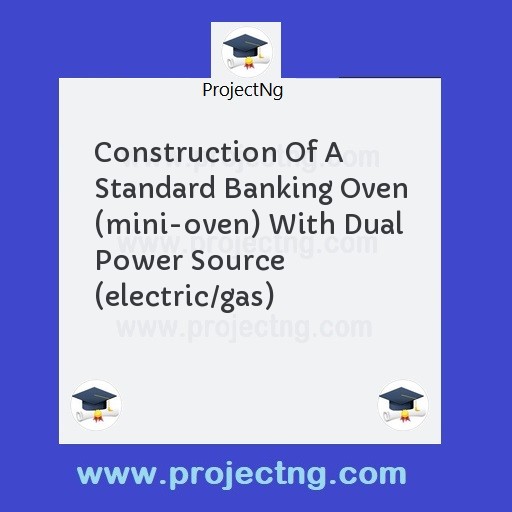Construction Of A Standard Banking Oven (mini-oven) With Dual Power Source (electric/gas)
Mechanical Engineering Project Topics
Get the Complete Project Materials Now! »
CONSTRUCTION OF A STANDARD BANKING OVEN (MINI-OVEN) WITH DUAL POWER SOURCE (ELECTRIC/GAS)
ABSTRACT
This project is designed to make the students utilize as many theoretical and practical concept as have been instructed in alstron to mechanical engineering workshop technology.
Students are expected to learn and apply concepts, principles about energy specially the conversions of electrical energy to thermal energy, conduction and conventional heat transfer etc.
Also the determination of the properties of various ferrous and non-ferrous materials, electrical installation occults. The application of engineering measurement and quality control.
Also to build an intellectual ability in interpretation of working drawing in designing and development before and after working process. Students will get an opportunity to appreciate safety, and the use of both machine and hand tools in the course of working.
TABLE OF CONTENT
Title page
Certification
Acknowledgement
Abstract
Table of content
CHAPTER ONE
BACK GROUND
1.1.0 Objective of project
1.2.0 Importance
1.3.0 Limitations
CHAPTER TWO
LITERATURE REVIEW
2.1.0 History of ovens
2.2.0 Types of oven
2.2.1 Conventional/standard oven
2.2.2 Fan forced oven
2.2.3 Microwave oven
2.2.4 Multi-functional oven
2.2.5 Solar oven
2.3.0 Mode of oven operation
2.3.1 Electrical section
2.3.2 Gas section
CHAPTER THREE
3.1.0 SAMPLE ACTIVITIES
3.1.1 Sequence of activities during operation
3.2.0 Summary of events
3.3.0 Graphic illustration
F.G.1.1 Obilique projection
F.G.1.2 Ontograhic projection
F.G.1.3 Sectional view
F.G.1.4 Circuit Diagram
CHAPTER FOUR
4.1.0 MATERIAL METROLOGY
4.1.1 Materials and Reasons for use
4.1.2 Behaviour of mild steel when heated
4.1.3 Graphic of heating and cooling curves for mild steel
4.2.0 Working tools use for project
4.3.0 Bill of Quantities
CHAPTER FIVE
5.1.0 Performance and evaluation of oven
5.2.0 Care and maintenance
5.3.0 Standards and symbols
5.4.0 Reading
5.5.0 Combustion of methane gas
5.6.0 Conclusion and recommendation
Bibliography
CHAPTER ONE
BACKGROUND
1.1.0 OBJECTIVES
This project is undertaken to
(1) Compare the various ways used in the production of an electric and gas oven.
(2) Disclose the different types of process in the manufacturing of an electric oven and also a gas oven in the past in comparison to the morden days method.
(3) Exploit the local facilities available in the construction of the oven as against imported ovens.
(4) To exhibit the usefulness of a dual-purpose oven in the economy and technology growth of the nation.
(5) To know the convenience in the use of alternate power source for operation of ovens.
(6) Discover the basic principle involved in the design and maintenance of a dual purpose oven.
1.2.0 IMPORTANCE OF OVENS
In actual analytical enunciation an oven is an enclosed chamber in which things are heated or cooked with various sources of power.
Its importance borders around its function, which are as follows;
(i) It is used to meet the everyday basic need of cooking, (baking, toasting, gritting, toasting) of food materials for human consumption.
(ii) Ovens are used for heat treatment of substance in laboratories and industries.
(iii) Also as a means of preservation by heat application to perishable materials (organic and inorganic) in general.
(iv) Sterilization of instruments and equipment for industrial use is done by heat application using oven.
(v) Expelling of moisture content to a required measure in some substance is also done using oven.
(vi) Early manufactured ovens where used as a source of room heaters during cold weathers in cold climates.
Other importance boarding around its energy source is that the use an alternative source of energy when either fossil fuel or electricity is not available. This can be relatively save cost when necessitated.
1.3.0 LIMITATIONS
Disadvantages in the use of ovens:
(i) Cleaning and repair is a difficult and time- consuming endeavor.
(ii) Expect for mass production singular construction is relatively expensive to produce.
(iii) If precautions are not well carried out, it can result in fire hazard, which is dangerous to life and properties.
(iv) Because ovens provides heat for one or more areas, the temperature may vary in different areas of the oven.
(v) Oils and moisture collected on metal surface can end up trying to rust the metal coating if not clean regularly.
(vi) It is expensive to operate in high volume operations.
(vii) Speed seem to be the key factor and time taken to get to required constant temperature can be wastage of time.
(viii) Access to internal component n case of adjustment and maintenance is tasking as it requires an entire disassembling.
(ix) In case of mechanical faults resulting from shut down, an entire disassembling and requires is required.
(x) Due to its function by heating, there is always a premature wear or mechanical failure of some of the internal component.
Be the First to Share On Social

Enjoying our content?
Don't miss out on new videos! Subscribe to our YouTube channel for more awesome content.
Subscribe Now!













